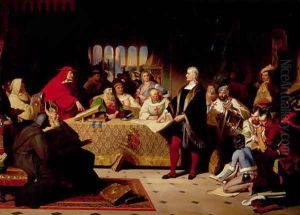William H. Powell Paintings
William Henry Powell, an American artist, was born on February 14, 1823, in New York City. Not much is documented about his early life and education, but it is known that he developed a strong interest in art during his youth. Powell's artistic journey began in earnest when he traveled to Europe to study under the tutelage of renowned painters. This exposure to European techniques and classical art profoundly influenced his style and the development of his artistic skills.
Powell is perhaps best known for his historical genre paintings, which often depicted significant events in American history with a romantic flair. His works were characterized by their dramatic compositions, attention to detail, and vivid portrayal of historical figures. He had a particular interest in the events surrounding the American Revolution and the early years of the United States, which was a source of inspiration for many of his paintings.
One of Powell's most famous works is 'Discovery of the Mississippi by De Soto,' which was commissioned by the U.S. Congress in 1848. This monumental work, completed in 1853, earned him great acclaim and was installed in the Rotunda of the United States Capitol in Washington, D.C. His skill in capturing the grandeur and significance of historical moments solidified his reputation as a leading historical painter of his time.
Throughout his career, Powell received various commissions that allowed him to contribute to the visual documentation of American history. He also exhibited his works at major institutions, such as the National Academy of Design, and was recognized by his peers for his artistic contributions.
Unfortunately, Powell's career was cut short when he died on October 6, 1879, in New York City. Despite his relatively brief life, his artistic legacy continued through the historical paintings that remain on display and are cherished as part of the country's cultural heritage. Powell's works continue to be studied and admired for their historical value and their place in the narrative of American art history.



